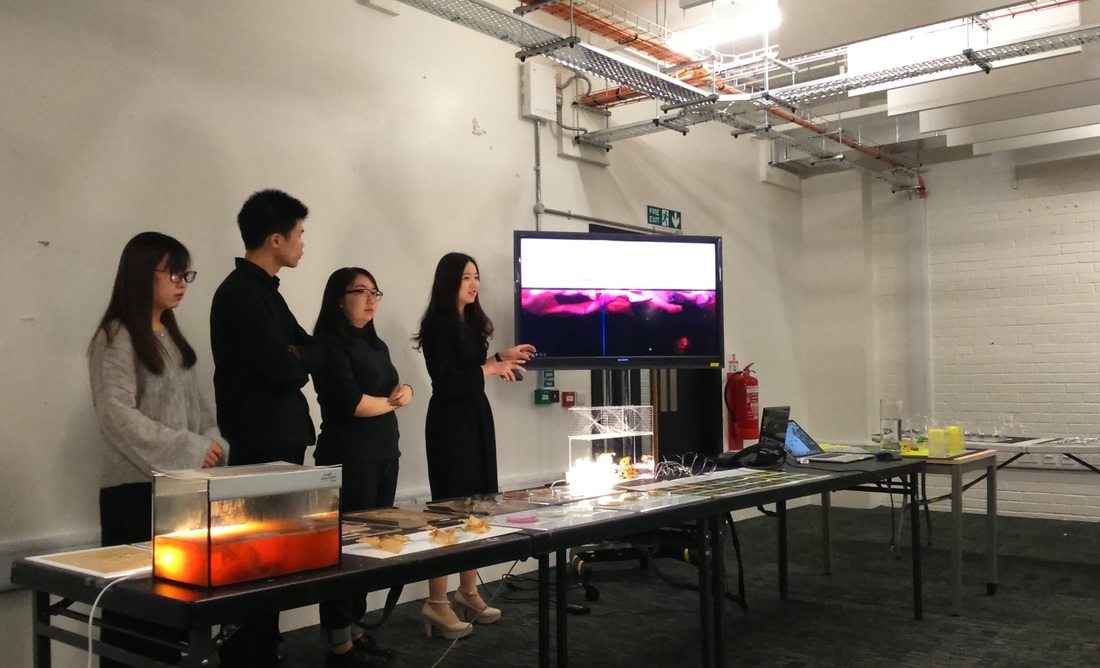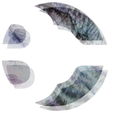|
Urban Morphogenesis Lab at The Bartlett, University College London, runs one of the world’s foremost education and research programmes in experimental architectural and urban biodesign. Led by architect Claudia Pasquero of ecoLogic Studio, the Masters programme produces persistently compelling and creative concepts, meaning it’s always a great pleasure to engage with its staff and students. On December 18th I joined the Urban Morphogenesis Lab jury to critique Research Cluster 18’s Term #1 output, which included an array of original biodesign concepts intended to tackle critical now and near-future architecture and urban problems. All manner of biological materials, processes and approaches were explored, including research-led architectural applications for bacteria, biorock, slime mould, bioluminescence, chemiluminescence, and Mycorrhizal fungi. Read more about the Urban Morphogenesis Lab below, and at this link. “The Urban Morphogenesis Lab is interested in process of material computation and how those can have a radical effect in the way we can re-conceive cities for the post anthropocene. From a methodological point of view we look at bio-science, as well as landscape engineering techniques, to investigate how we can go beyond digital and descriptive simulation so to start working with materials to define a new way of computing our cities. We believe that there is an interest in augmenting material through sensors and microprocessors so that we could start harvesting the computational power present in bacteria, sand, fungi and the like, we dream of an era where descriptive computation will be overcome and computer will become superseded by our capability to simulate and compute through the world that is surrounding us. From a social point of view we look at pre-industrial societies and in particular at the relationship they established with natural system, their ability to communicate with the world surrounding them, their power to harvest processes so to try and recuperate some of these to define new ways of interacting with the built environment. Pre-historic communities were able to interrogate nature or better their material surrounding. The case of the Incas population is exemplary, they would interrogate their mountains before extracting minerals from it, this type of interrogation were conducted via a set of procedure that they would define magical but with today’s knowledge of material computation and of the mind we could define as pattern recognition. In a similar manner in a pre-industrial community in Europe the population was able to predict events such as weather, insect arrivals, etc. by reading signs in the environment surrounding them. We have lost this capacity and we became mere consumers of the facility of the world. We argue here that a new transition from consuming data to reclaiming a computational 'magic' should be made, this time though with a different consciousness of our capability of reading patterns, forecast and create via intuition, poetry and art. The capability of the single individual in the city to read matter and processes around him/her would change completely his /her perspective; from the one of consumer to the one of designer. This could trigger a series of processes of self-organization that would enable cities to grow as a result of interaction rather than as a result of planning and engineering. This would enable us to completely re-describe the current relationship between the Urbansphere and the Biosphere.”
0 Comments
Your comment will be posted after it is approved.
Leave a Reply. |
AuthorMelissa Sterry, PhD, chartered design scientist, systems theorist, biofuturist, and serial founder inc. Bionic City® Bionic CityAsking the question "how would nature design a city" since 2010.
Archives
October 2023
Categories#bionics
#biotech #biodesign #bioscience #biomimetics #biotechnology #bioengineering #bioinnovation #bioaesthetics #biorevolution #bioenterprise #biosystems #biocreative #biofuturism #biofutures #biocentric #biofacture #biotecture #biovation #biofiction #biourban #biocities #biolab #bioart #STEM
#STEAM #STEAMED #STEMcomms #STEAMcomms #STEAMEDcomms © Bioratorium Limited & Melissa Sterry
2021 All Rights Reserved |


 RSS Feed
RSS Feed

